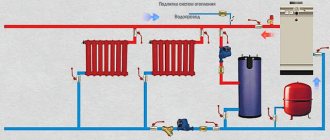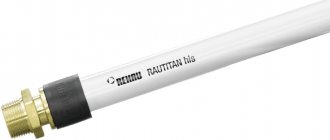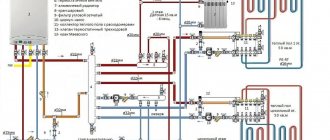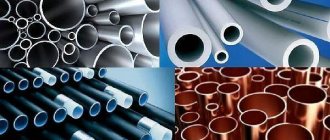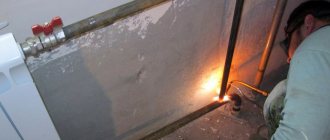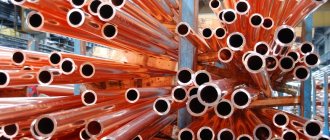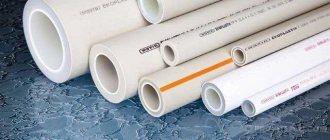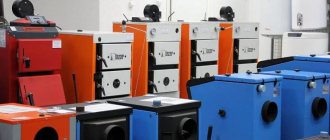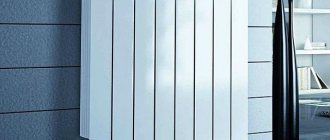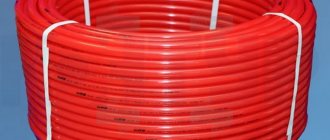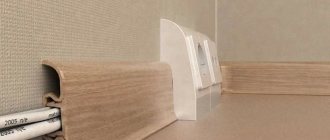What is the difference between heating pipes made of different materials? What are the features of connections and what else should you pay attention to when choosing?
The heating boiler has been selected and purchased, you can begin to supply heat to the house. But how to choose the right pipes for your heating system? The situation is approximately the same as with boilers: manufacturers praise their products, and in stores they try to sell what is more expensive. On the Internet, opinions vary even more.
There are no downright bad pipes. Each technology has its pros and cons, and the quality of the entire pipeline depends on the correct combination of pipe material and the method of their connection.
Features of operation and installation of pellet boilers
Although pellet boilers are classified as solid fuel equipment, they are an order of magnitude better than traditional units that burn wood or coal, because:
- dry pellets burn, giving off much more heat, which significantly increases the efficiency of the unit;
- during operation, a minimum amount of fuel combustion products is produced;
- loading pellets into the bunker is carried out much less frequently than when using firewood or coal.
This effect is achieved thanks to the special design of the equipment, as well as through the use of highly efficient pyrolysis combustion processes. An important point when operating a pellet boiler is the humidity of the fuel, which should be less than 20%. If this requirement is not met, the power of the equipment will subsequently decrease and condensed moisture will enter the system. And this can very soon lead to serious equipment breakdowns.
There are combined pellet boilers, which have two fireboxes: one for burning pellets, the other for conventional solid fuel. The efficiency of such units is somewhat lower than that of boilers that operate only on pellets, and the requirements for installation and piping remain quite high.
When installing a pellet boiler, it is necessary to install a hopper, a burner and a screw mechanism for feeding pellets. Experts often recommend using a special buffer tank, the volume of which can be 50 liters for each kW of pellet boiler power. All this significantly increases the size of the boiler room in which the equipment will be installed and connected.
Video description
This video explains how to connect a gas double-circuit boiler with your own hands:
Floor-standing
Floor-standing equipment is installed directly on the floor or on a slight elevation so that it is below the wiring. Otherwise, air pockets will form in it. Such boilers are usually not equipped with a built-in safety group, pump and expansion tank; they are purchased and installed separately. Therefore, piping a floor-standing boiler is somewhat more complicated than a wall-mounted one.
These devices can only be dispensed with when installing a gravity-fed heating system by installing only an open expansion tank at its highest point. When heating a large cottage, this scheme does not work well, so closed circuits with a circulation pump are used. In the case of a single-pipe system, the temperature of the coolant at the return before entering the boiler may be too low (less than 40 degrees), which leads to the formation of condensation. A jumper between the supply and return, on which a circulation pump or three-way valve is installed, helps to avoid its occurrence.
Circuits with a jumper - No. 2 and 3 Source mr-build.ru
When using an additional pump, a temperature sensor is installed underneath it in the section of the jumper leading to the return line, which turns on the pump when it drops. It takes hot water from the supply pipe and mixes it with return water, equalizing the temperature.
Piping a floor-standing gas boiler according to a different scheme is done using a three-way mixing valve, which cuts into the return pipe and connects it to the supply pipe with a vertical jumper.
The valve is equipped with a thermostat to set the temperature at which it opens and mixes water. Source i-reshenie66.ru
As can be seen from the diagrams, the safety group is placed at the supply outlet of the boiler, and the expansion tank and pump are located at the return before entering it.
When piping a boiler with a heated floor and radiators, additional devices are required - collectors that distribute flows to different circuits and collect them on the way back.
Single-circuit and double-circuit heating boiler.
A single-circuit boiler has a fairly simple operating principle. During installation, it is connected to the chimney. For the normal functioning of the system, the presence of normal natural draft is sufficient.
Often, single-circuit boilers are installed, which in their design have an open combustion chamber, which requires the creation of certain conditions in the room.
During its operation, the boiler uses air from the room. That is why it should be installed in a separate room. It is worth noting that when a single-circuit boiler operates, substances and gases harmful to the human body accumulate, this is the main reason for the need to equip a room with a boiler with a chimney or hood. If all the above conditions are created, the risk of explosion will be eliminated and will also ensure the safe use of the equipment.
A double-circuit heating boiler differs from a single-circuit analogue in its universal purpose: it maintains the degree of coolant in the heating circuit and heats water for domestic needs. Single-circuit generators can also indirectly heat water. The heat transfer process is carried out during the passage of the coolant through the secondary heat exchanger.
The main difference between a double-circuit boiler and a single-circuit boiler is the direct transfer of thermal energy to water. The main feature is that when hot water is consumed, the coolant is not subject to heating, and parallel operation of two circuits is excluded. Practice shows that the operating mode of the boiler is not important for houses with high-quality thermal insulation, it follows that with thermal inertia, the heating circuit will be the same for any type of heating. An impressive volume of hot water can be obtained by combining a single-circuit design and heating columns.
A double-circuit boiler should not be designed in combination with a natural circulation system, since after heating of the coolant stops, the movement of the liquid quickly stops. The secondary heating process takes quite a long time, and the heat in the radiator is distributed unevenly.
The main advantage of the scheme is the ability to operate in natural circulation mode. The booster of the collector in this case is a pipe through which the coolant moves to the upper filling.
Two-pipe circuit with horizontal wiring
It is also suitable for one-story houses. However, it can be implemented with your own hands in houses with an area greater than 100 square meters. m. The number of radiators may exceed 5.
Its features (they can be seen in different photos) are as follows:
- The supply line is either under the ceiling or runs under the windowsill. In the first case, there is no need to include an accelerating manifold in the pipe distribution, because the hot water is already at a high altitude. In the second option, such a collector is necessary.
- The coolant supply line and radiators are connected by vertical pipes. Depending on the design option, they can be long or very short.
- The return line is located below the floor. It is also connected to the battery by a separate pipe.
- Both lines are placed at an angle. The feeder is inclined towards the batteries, the second - towards the boiler.
Single-circuit boilers with DHW supply
To provide hot water supply, along with a safety group, a pump and an expansion tank, the piping of a single-circuit gas boiler must include an indirect heating boiler. A connection diagram for an indirect heating boiler with recirculation is possible. In this case, water is heated thanks to the coolant from the heating circuit. This leads to the appearance of two circulation circuits - a large one (through the heating system) and a small one (through the boiler). Each of them has shut-off valves, which allows you to turn them on separately. To break the supply bottling, a piping scheme is used for a single-circuit boiler with a boiler, immediately behind which a bypass with a tap is installed.
Installation of expansion tank
When heated, the density of water changes and it expands. If there is not enough space for the coolant, pressure begins to increase, leading to an explosion. If there is a tank, excess coolant goes into it. This approach is a way out to maintain pressure stability. The size of the tank also matters.
Inexperience allows the wrong choice of expansion tank. It is worth keeping in mind that they differ in purpose and color. The heating system uses a red tank.
When connecting the system, you should create the required pressure in the tank - the factory parameters usually do not correspond to the norm.
What is heating boiler piping
Piping a heating boiler is connecting a gas boiler to the heating system, water supply (if provided) and gas as fuel. The boiler wiring includes the connection of all necessary devices that ensure reliable operation and control of the boiler.
According to construction regulations and manufacturers' instructions, gas supply to the heating boiler must be carried out only through a rigid connection. By rigid connection we mean a metal pipe, and the connection is made using plumbing technologies for connecting metal pipes, through a metal “squeeze”. Polypropylene pipes with fiberglass for hot water supply are also suitable. If you live in Kazakhstan, you can view and download the pipe catalog on the Allpipes.kz website.
Important! To seal gas supply pipe connections, EXCLUSIVELY paronite gaskets are used. Other gaskets such as rubber, as well as sealing the threads of connections with fum tape and tow are PROHIBITED. Paronite is a sealing material based on asbestos, mineral fibers and rubber, made by vulcanization and is non-flammable
Paronite is a sealing material based on asbestos, mineral fibers and rubber, made by vulcanization and is non-flammable.
Video description
To understand how to connect both radiators and heated floors to the boiler, watch the video:
Which scheme to choose for piping an autonomous heating boiler depends on its type and installation method. A minimum of additional equipment will need to be installed when installing a gravity system - only an expansion tank and taps that cut off the boiler from it. With automatic continuous boilers it will be a little more complicated: for their stable operation, you will need to install a circulation pump, a safety group and a membrane expansion tank. You can connect a heated floor or a hot water boiler to the system using collectors.
What types of pipes can be used?
When carrying out installation work on a heating boiler, elements made of metals and polymers can be used
When choosing, you should pay attention to such characteristics as thermal insulation properties, ease of installation and operation, durability, as well as the cost of products
Based on the sum of these criteria, the following types of pipes are used to perform piping.
High-quality but expensive copper products
Copper piping is relatively rare, since such pipes are quite expensive and also require special skill during installation. At the same time, structures made from this metal have a number of significant advantages, namely:
- good heat dissipation;
- resistance to corrosion and aggressive substances;
- resistance to freezing;
- high heat resistance.
Copper heats up quickly and well with a minimum amount of thermal energy, so parts made of this material will constantly generate heat during the transportation of the coolant.
Copper pipes can withstand significantly higher temperatures than plastic ones (up to +300), while they practically do not change in size. Hot coolant can also circulate in steel structures, but in this case the risk of corrosion increases
Pipes made of this metal can withstand environmental influences. Over time, they can only become covered with a thin layer of oxide, which does not affect the performance characteristics at all. Unlike pipes made of steel or polymers, ductile copper structures do not burst when the coolant in them freezes.
The disadvantages of products made from this metal include the inability to use pipes to create closed structures in grooves, as well as the already mentioned high cost.
Budget steel products
Another common option is products made of steel. Their advantages include:
- High strength, allowing you to easily withstand mechanical loads.
- Low temperature coefficient of linear expansion, due to which the length of the parts remains unchanged even at high temperatures.
- High thermal conductivity, allowing efficient heat transfer.
The disadvantages, first of all, include the tendency to corrosion, which destroys the metal, which is why such elements need to be painted or coated with an anti-corrosion compound.
The disadvantage of steel elements is that they are difficult to install, requiring special equipment and professional skills. The manufacture of structures from such elements must be trusted to specialists
When choosing, it is better to give preference to stainless steel pipes: they are more expensive, but they demonstrate greater resistance to environmental influences and better performance characteristics.
Durable and lightweight polypropylene pipelines
Similar products made from modern types of plastics have become widespread due to many positive aspects:
- Affordable cost: prices for such products are much lower than for metal analogues.
- Light weight. Such elements weigh very little, thanks to which you can save effort and money on their storage, transportation and installation.
- Easy to install. Plastic pipes are easily assembled into finished structures. With the help of a special soldering iron, even a non-specialist can quickly arrange the wiring.
- Coolant circulation rates. Polypropylene pipes, even if they have a complex shape, practically do not form blockages. This facilitates the flow of water, the speed of which remains unchanged throughout the entire service life (20-50 years).
- Good resistance to high pressure. This allows the use of plastic elements even under difficult operating conditions.
The main disadvantage of PPR pipes is their high coefficient of thermal expansion, due to which these products slightly increase in length when heated. To counteract this phenomenon, measures must be taken by installing compensators.
Polypropylene pipes allow you to create heating circuits of any degree of complexity. However, designs with a large number of elements make installation difficult and negatively affect the efficiency of the heating system
In addition, there are special pipe options, which include aluminum foil-reinforced products marked PN 25 (they can be used in systems with pressures up to 2.5 mPa and temperatures of +95°) as well as reinforced PN 20 elements that allow operation in temperatures of + 80o C and pressure 2 MPa.
Features of gas heating in the apartment
Before you begin dismantling the old heating system and purchasing the components of a new one, you should obtain permission to install a gas boiler for heating the apartment from the gas service, fire supervision and BTI. This is quite a troublesome matter and the applicant may be refused. Therefore, only after receiving all the necessary documents should you begin purchasing the unit and other elements of the system.
Choosing a gas boiler for an apartment
First, choose a gas unit. By the time official consent is received for the installation of this device, it is already determined which gas boiler to choose for heating the apartment, since for approval it is necessary to provide technical documentation for the proposed device.
For placement in an apartment, a wall-mounted unit with a closed combustion chamber is usually chosen. Depending on the need for hot water, choose a single-circuit or double-circuit device
It is also important to correctly calculate the required power of the unit in accordance with the area of the apartment, the degree of wall insulation, and the availability of hot water heating
If the owner wants to connect additional systems to the unit, for example, “warm floor”, then it is better to purchase a condensation model
It is able to work very economically at a coolant temperature of 50-60°C and produce an efficiency of 97-99%. Important! If the temperature of the coolant in the condensing unit heats up above 60°C, then it already operates with the efficiency of a convection boiler
Selection of radiators and pipes
Gas heating wiring can include both metal and plastic pipes. If the owner is going to install the heating system with his own hands, then a plastic pipeline is an easier option. Only a professional can install metal pipes.
There are several schemes for organizing a heating system. The most common and most suitable for apartments are single-pipe and two-pipe schemes. The first option is more economical, but if the pipe is clogged, the entire system will become worse at heating the apartment. For two-pipe heating it will be necessary to spend more material, but if a problem occurs in one pipe, the coolant will be able to circulate through the second. With a single-pipe version, a diagonal connection is ideal, then the coolant will be in contact with the inner surface of the radiators.
For one-room and two-room apartments of standard size, a single-pipe system is suitable, and for large living spaces, a two-pipe system is suitable.
When installing a heating system made of plastic, it is allowed to use only reinforced polypropylene pipes. Unlike conventional products, this material is not subject to corrosion and expansion from exposure to high temperatures. These types of pipes are reinforced with aluminum foil or fiberglass. Thanks to this, polypropylene products can withstand heating up to 70-90°C.
…Important! Antifreeze or water acts as a coolant for gas heating. When choosing a radiator, in stores you can find products made of cast iron, steel or bimetallic (mixtures of steel and aluminum)
It is the latter that have the best performance, so consumers often opt for such batteries. In this case, it is important to correctly calculate how many elements will be needed to heat each room.
Heating and water supply pipes
All instructions and standards state that the connections of water pipes and heating pipes with a gas boiler must also be rigid. This means that you can use any pipes to connect a gas boiler, and the connection of the heating and water supply pipes with the gas boiler is made through metal pipes.
The connection of pipes in the piping is carried out according to the standards of simple plumbing connections, namely:
- Metal threaded connections are made with sealing winding;
- Polypropylene pipes are connected using special welding;
- Polyethylene pipes are connected using compression fittings;
- Metal-plastic pipes are connected by collet joints or compression fittings;
- Copper pipe connections are soldered or connected with a collet.
Disassembly type
Attic stairs are classified according to the method of disassembly. Let's consider the basic mechanisms.
Manual
Using a special cane mounted in the ceiling, the assembled structure is hooked onto a special hook and pulled towards itself. Often it is not necessary to apply much force to get the ladder into working position.
With drive
Electric ceiling products allow automatic extension of the stairs using a remote control.
How and what to seal pipe joints with
Types of seals, sealing methods
To prevent leakage of the pipeline working fluid, it is necessary to properly seal the pipe twists.
When threading steel pipes, the following are used as seals:
- gasket This method of sealing a threaded connection requires relatively thick end pipe cuts. The presence of smooth pipe ends can never ensure tightness. When using a rubber or plastic gasket, this problem is successfully solved. This option is ideal in case of articulation using a union nut;
- winding The materials can be linen strands, polymer threads, FUM tapes in combination with hardening sealants, paints, pastes.
When installing plastic risers, a sealing method is used based on the deformation properties of the material. The essence of this method is that a plastic pipe with an external thread is screwed into a riser with an internal thread. During deformation, plastic contributes to excellent filling of the intermediate space, eliminating the appearance of gaps.
When it comes to pipeline structures with high pressure, cylindrical threaded pipe connections are not entirely appropriate here. In such cases, a conical type connection is used. The principle of connection is that when screwing in, the pipes are tightly pressed until the gap completely disappears.
Materials for sealing joints
To make the joint impenetrable, the following are used as seals:
- flax (tow);
- asbestos;
- FUM tape;
- natural drying oil;
- whitewash;
- minium;
- graphite lubricant, etc.
A reliable sealant when twisting steel pipes onto threads is strands of flax impregnated with red lead or white lead. This connection is easy to install and reliable in terms of sealing. The seal has been used for a very long time and does not lose its popularity today, despite the emergence of artificial analogues.
For those who have little experience in installing fittings and pipes, we suggest that under no circumstances use flax without paint.
At first, the joint will not allow moisture to pass through. But several months will pass, the flax fibers will get wet and begin to decompose. Therefore, the quality of all connections will deteriorate, and in another month or two, water will leak at the junction.
Many people use FUM tape, which is in no way inferior to old traditional materials - tow with paint.
Sometimes there is no tightness at the junction of the risers. To eliminate this defect, you need to replace the sealing material, and clean the threaded area from dirt and sealant residues. After this, rewind the linen thread, FUM tape or other sealant, and assemble the structure.
Pastes and sealants of chemical origin are used as additional sealants, which will help strengthen this section of the pipeline.
Detachable and press connections
To make a press connection, you need a specialized tool - crimping pliers. They are available both manual and electric. After stripping the pipe and fitting, they are combined, pliers are applied to the joint from the outside and crimping is performed. The connection is considered permanent and quite reliable.
Detachable coupling is done following the example of metal-plastic pipes, since the principle of combining a brass fitting with a pipe is exactly the same. Accordingly, the cost of the connector is several times higher than that of a soldering fitting. But for installation you only need 2 wrenches. Details of the work are presented in the video:
Recommendations for installing the battery yourself
- Before starting work, you need to shut off the flow of coolant in the heating system at the inlet and outlet or make sure that there is no liquid in the pipeline.
- Even before installation, you need to check that the radiator is complete. It must be assembled. If this is not the case, take a radiator key and assemble the battery according to the manufacturer's instructions.
The structure must be absolutely sealed, so abrasive materials cannot be used during assembly, as they destroy the material of the device. When tightening fasteners, do not forget that bimetallic devices use both left-handed and right-handed threads. When connecting sanitary fittings, it is extremely important to choose the right material. Typically, flax is used together with a heat-resistant sealant, FUM tape (fluoroplastic sealing material) or Tangit threads. Before starting installation work, you need to carefully plan the connection diagram. Batteries can be connected in a diagonal, side or bottom pattern
It is rational to install a bypass in a single-pipe system, that is, a pipe that will allow the system to function normally when the batteries are connected in series. After installation is complete, the system is turned on. This must be done by smoothly opening all the valves that previously blocked the path of the coolant. Opening the taps too sharply leads to clogging of the internal pipe section or hydrodynamic shocks. After opening the valves, it is necessary to bleed off excess air through an air vent (for example, a Mayevsky valve).
Batteries can be connected diagonally, sideways or downwards. It is rational to install a bypass in a single-pipe system, that is, a pipe that will allow the system to function normally when the batteries are connected in series. After installation is complete, the system is turned on. This must be done by smoothly opening all the valves that previously blocked the path of the coolant. Opening the taps too sharply leads to clogging of the internal pipe section or hydrodynamic shocks. After opening the valves, it is necessary to bleed off excess air through an air vent (for example, a Mayevsky valve).
Note! Do not cover batteries with screens or place them in wall niches. This will sharply reduce the heat transfer of the equipment. Correctly installed bimetallic heating radiators are the key to their long and trouble-free operation
If you have any doubts about your ability to install them yourself, it is better to contact a specialist
Correctly installed bimetallic heating radiators are the key to their long and trouble-free operation. If you have any doubts about your ability to install them yourself, it is better to contact a specialist.
Advantages and disadvantages
It must be said that systems assembled from copper pipes are closest to the ideal, since they have numerous advantages with a minimum of disadvantages:
- corrosion resistance and durability;
- ability to withstand high temperatures. Copper will withstand environmental temperatures up to 300 ºС for a long time, although the maximum temperature in centralized heating systems does not exceed 115 ºС, and when we mean heating a private house, even less - 95 ºС;
- resistance to pressure drops and water hammer. In accordance with GOST R 52318–2005, a drawn copper pipe is destroyed at a short-term pressure of at least 220 MPa. Standard products are designed for a working pressure of 25 MPa (250 Bar). Similar technical characteristics of copper pipes allow them to be used in any heating systems;
- low weight compared to steel pipes;
- high thermal conductivity. An uninsulated copper pipeline passing through the room is also a heating device; this must be taken into account when selecting radiators and the number of sections must be smaller;
- solid and remarkable appearance;
- plastic. Thanks to this property of the material, copper pipes and fittings can withstand several defrost cycles.
A little about the shortcomings. You have to pay a lot of money for the high quality and reliability of copper systems, but they are worth it because they will last as long as the house itself costs. This material is suitable not only for installing radiator heating and heated floors; boiler piping with copper pipes is also considered one of the most durable.
Selection of heating pipes
Having figured out which heating boiler will heat the water in your home, you can choose pipes for heating radiators and the system as a whole. Traditional materials for heating pipes:
- steel;
- copper;
- plastic.
Quite expensive and requiring the invitation of professionals for welding, steel or copper pipes are increasingly being replaced in practice by metal-plastic or polypropylene pipes.
Metal-plastic pipes
The connection and installation of metal-plastic pipes can be done using crimp and press fittings.
To make a connection using compression fittings and subsequent connection of heating pipes, you will need:
- spanners;
- flarer;
- springs for bending pipes.
The main disadvantages of connections on compression fittings are:
- their cost is quite high;
- fragility of rubber gaskets under high temperatures;
- periodic “downtime” of heating pipes in the summer, which also does not have a very favorable effect on the durability of rubber parts.
As a result, the need for preventive work to tighten joints may occur every five years or more often.
Rules for connecting metal-plastic pipes using a press fitting
A reliable, permanent connection with press fittings allows you to install heating with plastic pipes, hiding them directly in the walls. These pipes will last for many years without replacement if the temperature of the heating water flowing through them does not exceed 80°C.
The only disadvantage of using this type of connection is the need to purchase special equipment for installation
Polypropylene pipes
Recently, a leading place among suitable water and heat supply equipment has been occupied by a pipe for a heating boiler made of polypropylene. The use of polypropylene is due to the fact that it is very durable, is not afraid of system defrosting, and has a very affordable price.
Polypropylene pipes can be bent quite evenly (unlike metal-plastic). They will last quite a long time if all operating rules are observed.
Their only drawback is the need to use a special tool for welding.
There are the following features of connecting polypropylene pipes by welding:
- It is more convenient to weld polypropylene pipes together with a partner. The main condition for a high-quality connection of plastic pipes is the choice of the correct heating time, so as not to overheat them, and precise fixation, which does not allow shifts and displacements along the axis in the first few seconds after connecting the heated parts.
- Welding and installation of heating pipes is carried out at positive ambient temperatures - above +5 °C. When working in winter, it is necessary to create a “heat zone” where polypropylene pipes are welded.
To carry out high-quality work on soldering polypropylene pipes, it is necessary to comply with all the requirements of the instructions supplied with the device.
It would be a good idea to carry out several test welds on individual short sections of pipe using inexpensive couplings to gain at least some initial skill in handling the welding unit.
Installation
Even the simplest piping, which is done by hand, requires a competent choice of pipes. Products as simple and beloved by many people as polypropylene pipes also need to be used correctly. The ease of operation should not be misleading, although you only need to use a soldering iron. It is allowed to use PN25 pipes, which are reinforced from the inside with aluminum foil.
To connect to a heated floor, you can tie the boiler with pipes of category PN10. Their walls are very thin and are designed to pump water heated to +45 degrees under a pressure of 1000 kPa. Polymer pipelines can be used in both open and hidden installation schemes, but thermal expansion must be taken into account. The connection of fittings to pipes is done either by creating a thread or using cold (hot) welding. Thread cutting simplifies the matter, but the cost of such a solution immediately increases.
Before welding begins, the foil must be cleaned, otherwise the strength of the connection can be forgotten. Glass fiber does not require such treatment when used for reinforcement. Cold welding using specialized glue is now almost out of use, since it does not guarantee a reliable joint. If two small heating boilers or more are installed in the system, piping with parallel oriented passages is allowed. As practice shows, this can be more economical than using a single boiler of the same amount of power.
To prevent water from moving through temporarily disconnected circuits, it is very important to ensure that they are closed with separating valves and other shut-off valves. In some cases, the equipment is mounted on a foundation pad (clay, 0.1 m high), on top of which sheet iron or asbestos is placed
The main requirement is to install the boiler at a lower level than installing the batteries. You need to resort to copper pipes only if you plan to heat a house with very high temperatures and pressures. In all other cases, there is no point in these expensive components.
Nuances and piping options for different types of boilers
General recommendations from experienced professionals:
The installation scheme is selected individually. The boiler is installed in accordance with SNIiP rules below the level of heating devices. Before lining with polypropylene, the floor-standing boiler is installed on a metal or concrete base. Forced ventilation and emergency lighting systems are recommended for all unit options. A coaxial chimney is included in the piping of a device operating on gas fuel, which is sealed at all joints during installation. After completing the piping of the boiler unit and chimney, proceed to installing a safety system in the following order: medium pressure devices (pressure gauges), protective devices and then an automatic air vent. The manifold circuit is made of a 1.25-inch PPR pipeline; protective devices, a circulation pump, a hydraulic arrow and an air vent are installed according to the movement of the medium. To supply the heating coolant to the heating devices, 3 branches of a 1.0-inch PPR pipe are removed from the comb, and the rest are closed with plugs. Connect heating and return devices. In a combined heating system, the underfloor heating circuit is equipped with an independent pump, while the expansion tank is installed between the hydraulic valve and the boiler unit. The piping of the boiler unit is completed by installing a drain valve; it is also used to fill the circuit, but it is better if these are two independent valves
The installation point depends on the chosen system, but there are general conditions - the drain valve is installed at the lowest point, which is especially important if you plan to mothball the system in winter so that there is no water left in it.
Gas equipment
The piping of such equipment with polypropylene pipes is carried out with an independent circuit and a circuit pump that creates operating pressure in a small section of the network from the source to the distributor.
It is allowed to tie a gas unit with such pipes without steel pipes, since the heating temperature at the supply does not exceed 80 C.
In a gas-powered unit with a cast-iron boiler, a heat accumulator is installed, which helps balance the hydraulic regime and prevents sudden temperature changes that affect fragile cast-iron heating surfaces. When piping 2-circuit boilers, it is additionally necessary to place fine and coarse water filters.
Electric heater
Tying an electric boiler with polypropylene is quite acceptable. The boiler has the highest rating for a protective system that prevents the water in the unit from boiling, with subsequent formation of steam and pipe rupture. The heating process stops when the power supply to the electric heating elements is turned off.
In addition, the system has built-in hydraulic accumulators and devices for relieving excess pressure of the environment, which can form during a sudden power outage and stopping the pump for pumping hot water to heating devices and water collection points.
Solid fuel boiler piping
Solid fuel models
This is the most problematic unit for piping plastic pipes. For it, the installation of a protective meter pipe at the inlet/outlet of the medium is mandatory in order to protect them from overheating. For systems with pump circulation, an additional backup power supply device will be required to continue cooling the boiler in the event of an emergency shutdown of the main source of electricity. In addition, a small gravity circuit is made with a small number of connected batteries to cool the boiler heating surfaces until all the fuel burns out.
According to the requirements of fire safety rules, the solid fuel boiler is covered with a protective casing, which significantly reduces heat loss from the walls of the combustion chamber to the boiler room and, consequently, the negative impact on PPR pipes
A small reminder for the installation of plastic pipes - the quality will be determined not only by the installation work, but also by the selected range of pipes. You should purchase all main and auxiliary boiler room equipment only certified from reputable suppliers. Polymer pipes do not require insulation work or painting, scale and corrosion do not form on them, and they are characterized by high noise insulation. The cost of the material is lower, and the pipes are lighter than those made of metal, so installation can be done by yourself.
Boiler room piping
Boiler room piping is work that includes installing a boiler (one or more) and connecting it to the distribution network and DHW system.
Installation of a boiler room can begin only after electricity has been laid, water supply and sewerage have been supplied and (if the boiler room is on gas) gas has been supplied.
The most ideal option for installing a boiler room is a separate room for the boiler. This is especially true for solid fuel and gas floor-mounted boilers. But this option is not always possible to implement.
In this case, for example, a gas boiler can be installed in a utility room or in the basement, equipped with specialized safety sensors.
The room where the boiler will be installed must be quite spacious and must have ventilation. Floor-standing boilers must only be placed on a flat surface. The stand under the boiler must be non-flammable and larger in diameter than the boiler. A wall-mounted boiler should not be adjacent to the wall.
Absolutely all boilers, regardless of their type, must be equipped with a pressure gauge, thermometer, power switching device, must have a fuse and an emergency thermostat. Gas fuel boilers are connected only through a metal pipe, protecting the connection with a paranit gasket.
Boiler room wiring diagram
First of all, a boiler with an expansion tank is fixed. After this, the pumps are installed, and safety and drain valves are installed on the boiler. Then, using special hanger holders, the pipelines are secured in such a way that the weight of the pipes is not transferred to the boiler.
After this, installation of pressure gauges, thermometers, thermostats and temperature sensors is carried out, electricity and grounding are installed. Only after this is testing and preparation for a trial run carried out.
Boiler copper piping
Copper is considered one of the best materials for installation and piping of a boiler room. After all, a copper comb is not subject to aging and deformation under the influence of the coolant supplied to it from the boiler. Its disadvantage is the high price and complexity of installation. But this opinion is wrong.
For example, if a polypropylene comb deteriorates, its installation and repair will cost much more. The copper comb, pumping group, as well as all piping are performed directly on site and for each boiler room individually.
Copper is one of those materials that humanity has been processing and using for a very long time. This metal is very technologically advanced. Copper pipes can be connected either by welding or soldering. However, scientific and technological progress does not stand still here either.
In addition to welding and soldering, press fittings appeared to connect copper pipes, which significantly simplified installation and reduced the time required for it. When piping boiler rooms, soldering or crimping is most often used to connect pipes.
The process of welding copper pipes is quite labor-intensive and requires special welding equipment and a fairly highly qualified welder. All this was the reason that soldering fittings and pressfittings began to appear on the market to connect copper pipelines.
The pressfitting is crimped with a special tool, and at the base it has a rubber seal in the form of a ring (however, these seals are the main disadvantage of these connections).
There are two types of solder used for soldering copper pipes: soft and hard. The difference between these solders is their melting temperature: soft solder is fusible, which means it is less durable. The hard one is, accordingly, refractory, and, naturally, more durable.
The pipe, in turn, can also be soft and hard. The soft pipe is sold in coils. It is convenient for installation in places where absolute evenness is not required. A rigid pipe does not bend and goes on sale in sections 5 meters long. It is used where pipes will be visible and, therefore, absolute evenness is needed.
An example of this would be a boiler room. Since there are a lot of detachable connections in it, it is necessary to use a combination: where greater strength and reliability of the connection is needed, and the joint can be hidden, hard solder is used, and where the joints should be visible, soft solder is used.
At the same time, the strength of the joint, which is sealed with hard solder, is much higher than the strength of the pipe and, of course, there are no polymer seals.
Heating system made of polypropylene pipes
The technical characteristics of the object and the amount of allocated funds affect the heating installation scheme. In apartments in multi-storey buildings it is connected to the Central Heating Network, and in private houses - with an individual boiler. Regardless of the type of object, the system can have one of three designs.
Single-pipe
The system is characterized by simple installation and quantity of materials. It uses one pipe for supply and return, which reduces the number of fittings and fasteners.
It represents one closed circuit with alternating vertical or horizontal placement of radiators. The second type is used specifically in private homes.
As the coolant passes through each radiator, its temperature decreases. Therefore, a single-pipe circuit is not able to heat the entire object evenly. There is also the difficulty of temperature control, since the heat loss factor is not taken into account.
If the radiators are not connected through valves, then when one battery is repaired, the heat supply is stopped throughout the entire facility. When installing such a network in a private house, an expansion tank is connected. It allows you to compensate for changes in pressure in the system.
A single-pipe circuit allows the installation of radiators with temperature controllers and thermostatic valves that allow for the correction of heat loss. Ball valves, valves and bypasses are also installed for repairing individual sections of the thermal circuit.
Two-pipe
The system consists of two circuits. One of them is for serving, and the second is for returning. Therefore, a larger number of pipes, shut-off valves, fittings, and consumables are installed. This increases installation time and budget.
The advantages of a 2-pipe network include:
- Uniform heat distribution throughout the entire facility.
- Minimal pressure loss.
- Possibility of installing a low power pump. Therefore, coolant circulation can occur by gravity.
- Repairing an individual radiator is possible without shutting down the entire system.
A 2-pipe system uses a passing or dead-end coolant flow pattern. In the first case, it is allowed to install batteries with the same heat output or radiators with different power, but with thermostatic valves.
The associated circuit is used if the thermal circuit is long. The dead-end option is used for short highways. When installing a 2-pipe network, it is necessary to install radiators with Mayevsky taps. Elements allow air to be released.
Placement of the system and its individual elements
The boiler is the main element of the heating system. Its design has a significant impact on the strapping device.
Wiring diagram for a floor-standing gas boiler
The piping scheme for a floor-standing gas boiler should be created so that the heat generator is installed on the floor or at a small height, but not at the highest point of the pipe distribution. Otherwise, air pockets will accumulate inside the boiler.
When using a boiler that does not have air exhaust, the supply line should be positioned strictly vertically. The presence of air exhaust can be determined by the pipes located at the bottom of the installation. The supply line and return pipe are connected to them. Typically, such pipes are found in gas and electric equipment placed on the wall. This structural feature must be taken into account when creating a piping scheme for a wall-mounted boiler - the ability to independently remove accumulated air greatly simplifies the operation of the device.
In some cases, the boiler is sold without additional accessories. In this option, the necessary devices must be purchased separately.
When purchasing, you should pay attention to the compatibility of devices and purchase the necessary adapters. Additional devices are often not required when the system has natural circulation
What elements does the diagram contain?
The wiring diagram is a complex made up of the following elements:
- Circulation pump.
- Valves for various purposes (safety, check, distribution, etc.).
- Expansion tank.
- Ball valves - drain, balancing, etc.
- Pressure gauge.
- Filters for purifying liquids from solid particles.
As a rule, most of these components are built into a wall-mounted double-circuit boiler, and there is no need to duplicate them in the external part of the system. Elements such as a circulation pump, expansion tank, all taps and valves are initially present in the boiler design as components.
A modern unit practically does not require the installation of external components, connecting directly to the system. The exception is non-volatile boilers that are not equipped with a circulation pump and other important elements.
An important element of the piping is air removal devices. A circulation pump can perform this function, but the efficiency of the process is low and takes a long time.
It is easier to install Mayevsky taps on radiators and place the supply pipeline in a vertical position (on non-volatile systems)
In addition, pressure and temperature monitoring devices, which provide information about the operation of the system, are of great importance.
Shut-off valves allow you to regulate or cut off the system lines in case of emergency situations.
How to connect a solid fuel boiler
The canonical connection diagram for a solid fuel boiler contains two main elements that allow it to function reliably in the heating system of a private home. This is a safety group and a mixing unit based on a three-way valve with a thermal head and a temperature sensor, shown in the figure:
The presented diagram shows how to connect the unit correctly and is used with any solid fuel boilers, including pellet ones. You can find various general heating schemes - with a heat accumulator, an indirect heating boiler or a hydraulic arrow, in which this unit is not shown, but it must be there. The method of protecting against moisture loss in the firebox is discussed in detail in the video:
The task of the safety group, installed directly at the outlet of the supply pipe of a solid fuel boiler, is to automatically relieve pressure in the network when it rises above a set value (usually 3 Bar). This is done by a safety valve, and in addition to it, the element is equipped with an automatic air vent and a pressure gauge. The first releases the air appearing in the coolant, the second serves to control the pressure.
How the scheme works
The mixing unit, which protects the heat generator from condensation and temperature changes, operates according to the following algorithm, starting from kindling:
- The firewood is just starting to burn, the pump is on, the valve on the side of the heating system is closed. The coolant circulates in a small circle through the bypass.
- When the temperature in the return pipeline rises to 50-55 °C, where the attached remote-type sensor is located, the thermal head, at its command, begins to press the three-way valve stem.
- The valve slowly opens and cold water gradually enters the boiler, mixing with hot water from the bypass.
- As all the radiators warm up, the overall temperature increases and then the valve closes the bypass completely, passing all the coolant through the heat exchanger of the unit.
This piping scheme is the simplest and most reliable; you can easily install it yourself and thus ensure the safe operation of the solid fuel boiler. There are a couple of recommendations regarding this, especially when piping a wood-burning heater in a private house with polypropylene or other polymer pipes:
- Make the section of the pipe from the boiler to the safety group from metal, and then lay plastic.
- Thick-walled polypropylene conducts heat poorly, which is why the surface-mounted sensor will openly lie, and the three-way valve will lag. For correct operation of the unit, the area between the pump and the heat generator, where the copper flask is located, must also be metal.
Another point is the installation location of the circulation pump. It is best for him to stand where he is shown in the diagram - on the return line in front of the wood-burning boiler. In general, you can install the pump on the supply side, but remember what was said above: in an emergency, steam may appear in the supply pipe.
The pump is unable to pump gases, so when the chamber is filled with steam, the impeller will stop and the coolant circulation will stop. This will speed up a possible explosion of the boiler, because it will not be cooled by water flowing from the return.
Way to reduce the cost of strapping
The condensate protection circuit can be reduced in cost by installing a three-way mixing valve of a simplified design that does not require connecting an overhead temperature sensor and thermal head. It already has a thermostatic element installed, set to a fixed mixture temperature of 55 or 60 °C, as shown in the figure:
Installing such an element definitely allows you to save on piping the TT boiler. But in this case, the possibility of changing the temperature of the coolant using a thermal head is lost, and its deviation at the output can reach 1-2 °C. In most cases, these shortcomings are insignificant.
How to connect 2 boilers in the system?
You can’t just randomly connect 2 devices, the system will either not work or will work incorrectly. It is necessary to use carefully designed and competently designed ones from an engineering point of view.
There are two main connection schemes, these are:
- Sequential, when all elements are connected to each other without additional nodes. In this case, one device will heat the coolant, and the second will reheat it;
- Parallel, in which the devices included in the circuit have 2 connection points and the boilers operate independently of each other.
The sequential system is more suitable for low-power boiler installations and is rarely used.
Serial connection is considered impractical, if only because it is impossible to remove one boiler without affecting the second. In fact, the problem is solved by installing bypasses and shut-off valves, but still parallel connection is preferable
Meanwhile, parallel connection in a single system of gas and electric boilers has many advantages. Therefore, it is used most often, despite the fact that this arrangement requires more materials and is considered more expensive.
In such a device, you can turn off one of the devices at any time and even remove it for replacement or repair, while the second one will continue to operate as normal.
Open heating circuit
The heating scheme of a private house with a solid fuel boiler and an open expansion tank is considered the most suitable for such heaters. The fact is that even with a sharp jump in temperature and pressure, such a system will remain operational.
The lack of electrical equipment allows the use of such a scheme far from civilized areas. In addition, when compared with a gas heating system, a solid fuel heating system is much cheaper. The natural circulation scheme also has a number of disadvantages:
- The appearance of corrosion in pipelines, since the system is open to free access of oxygen.
- Rapid evaporation of coolant from the expansion tank.
- There is a large difference between the coolant temperature in different parts of the circuit.
To prevent oxygen from entering the system and water not to evaporate so quickly, owners add oil to the expansion tank, which forms a protective film. When installing a wood-burning boiler room, a number of conditions must be met.
How to connect a heating boiler:
Equipment with open gravity system
With an open gravity system, the entire load falls on the open expansion tank.
It performs the following functions:
- takes away excess amount of coolant;
- compensates for increased pressure;
- removes air and hot steam when the coolant boils.
The volume of the tank should not be less than 10 percent of the coolant volume. More is possible. Install it at the top point of the circuit, where the accelerating manifold ends. From the tank, the filling goes back to the heat exchanger, with a slope that ensures that air pockets are removed and the coolant moves by gravity.
Cold water is usually poured through an open expansion tank to compensate for evaporation.
Connecting the boiler with a collector
The two schemes above appeared quite a long time ago. They are divided, depending on the method of assembling the circuit, into tee, manifold and mixed.
Today, the first option is gradually being replaced by a more innovative one - collector. Its main advantage is its high efficiency. But to implement it you will have to invest a considerable amount.
This kind of wiring involves installing a special water collector behind the pellet boiler - a collector for heating. Each pipe, radiator or tap connected to the building's heating system is connected to this element.
The collector is installed in a specially equipped cabinet. Hot water flows to it immediately after heating by the boiler. Only after this the coolant is distributed through the pipeline.
The advantages of this scheme are obvious:
- the home owner gets the opportunity to separately control each heating circuit;
- stable water pressure is maintained at any point in the heating system;
- Only one pipe goes to one radiator from the collector; accordingly, they can be of a smaller diameter.
It is important to understand that this level of comfort will come at a cost. After all, each individual component of the heating system will have to lay its own pipeline
As a result, this will lead to the need to increase the budget, greater consumption of fittings, pipes and other fittings.
Organizing collector wiring is a complex and scrupulous procedure. Therefore, the best solution would be to entrust the work to qualified specialists, which will avoid mistakes and additional financial expenses.
Peculiarities
If a heating apparatus can be likened to the heart of a heating system, then the boiler piping is the vessels and peripheral organs.
When using such a system, the following actions are carried out:
- ensures normal temperature in heating circuits;
- the air contained in the line is discharged;
- a normal supply of coolant is maintained;
- the uniform heating of heating devices is monitored;
- supports connecting various heating circuits and adjusting them to a particular temperature;
- increasing the efficiency of distribution of the resulting heat.
Optional elements
What other elements can be included in the piping of a floor-standing or wall-mounted boiler?
Thermal accumulator
This is the name of a metal or polymer tank with thermally insulated walls. As the name suggests, it serves to store thermal energy.
This is useful in two cases:
- When using a solid fuel boiler. Heat accumulation allows you to increase the period of time between lighting and operate the boiler at rated power (and, accordingly, with maximum efficiency);
- When heating the house with an electric boiler and having a two-tariff meter. At night, when the price of a kilowatt-hour of electricity is minimal, the boiler heats water in the heat storage tank, and during the day the accumulated heat is used to heat the home.
Heat accumulator in a home boiler room.
The use of a heat accumulator implies the presence of two circuits, at least one of which operates with forced circulation. The first ring connects the boiler heat exchanger and the tank, the second - the heat accumulator and heating devices.
Connection diagram of the heat accumulator to the boiler and heating circuit with recirculation.
Hydroarrow
Hydraulic arrow with pipes for connecting several circuits.
In essence, it is just a thick pipe with several inlets and outlets. The function of the hydraulic arrow is to synchronize the operation of several circuits with different coolant temperatures (for example, radiators and heated floors).
The water temperature in the heated floor pipes is no more than 40 degrees.
Each circuit is equipped with its own pump and (in the case of a low-temperature circuit) a three-way valve that recirculates the coolant.
In some cases, the function of a hydraulic arrow is performed by a heat accumulator.
How is this possible?
Inside the tank, slowly circulating water is divided by temperature: the hottest (and least dense) coolant collects in the upper part of the tank, the coldest in the lower part.
By drawing water from pipes located at different heights, you can obtain any temperature in the range from boiler supply temperature to room temperature.
The photo shows the connection of the heat accumulator to multi-temperature hot water systems and heated floors.
Collector
Heating manifold.
One of the problems with connecting heating devices in series is the temperature variation between them. The supply radiators are always hotter than the return radiators, which leads to uneven heating of the rooms in the house.
The manifold allows you to connect several convectors, radiators or underfloor heating circuits in parallel. Each collector outlet is equipped with its own tap or throttle, allowing independent shutdown and adjustment of devices.
Manifold heating distribution.
Indirect heating boiler
Typically, to heat hot water, it is practiced to use a double-circuit boiler with a flow-through heat exchanger.
However, this solution has a couple of unpleasant drawbacks:
- Simultaneous operation of heating and instantaneous water heater requires a large power reserve. If you have an electric boiler and a power of 10 kW is allocated to your house, you will have to choose between warm rooms and a hot shower;
- Most instantaneous heaters do not allow precise control of the outlet water temperature. Trying to take a shower or wash the dishes becomes a constant battle with the taps.
An indirect heating boiler is a typical storage water heater without both problems. It connects to the heating circuit and takes some of the heat from the coolant.
Indirect heating boiler.
In summer, circulation occurs in a small circle - between the boiler and the boiler.
Connecting the boiler to the boiler.
https://youtube.com/watch?v=owCRvUbz1CI
What should I pay attention to during installation?
Each connection must be of high quality. The piping of a solid fuel heating boiler should take into account the off-season - this will avoid overheating in the house. In most cases, circuits with 2 circuits are used. The higher the quality of all the elements and parts used, the better the harness itself will be. Cheap, low quality parts are a sure way to waste. Pipes made of flammable materials must not be used! Polypropylene is only possible if it is certified. Pay attention to the dimensions of the expansion tank - the larger the piping, the larger they should be. Thanks to regular maintenance, the system will always work properly. Natural circulation is advisable only for small areas. The working fluid must be clean, without any impurities. It is recommended to use paronite in connections to prevent possible leaks. Using an air vent will prevent air from the line.
As a conclusion
As you can see, piping a solid fuel heating boiler is an extremely labor-intensive and complex process that requires not only specific skills, but also appropriate education. And only with a professional approach will the system be durable, effective and, most importantly, safe! Therefore, it is better to entrust this work to a professional, because amateur efforts in such cases may not only not bring results, but also be dangerous for you and others.
Good luck with your work!
Application of buffer tank
The wiring diagram for a solid fuel boiler with a battery tank is not widely used. It is quite cumbersome, but allows for more correct heating operation. Its advantages:
- Stabilization of temperature in the system due to the increased volume of water in the circuit;
- Possibility of reducing the number of approaches for adding fuel to the boiler furnace due to the accumulation of excess heat in the storage tank;
- Possibility of accumulating clearly unnecessary excess thermal energy when using too powerful a boiler or excessive stacking of firewood.
The heat accumulator circuit has one drawback - it is necessary to allocate space for the device itself. The volume of the container used reaches several hundred liters, so you will need free space to place the tank.
There are many schemes for connecting buffer tanks. The simplest of them involve the use of the same coolant in the boiler and in the heating system. A more efficient scheme is using a three-way valve with a thermostat, which ensures a more uniform and economical consumption of thermal energy from the buffer tank.
Schemes with two circuits are also used. In this case, heat accumulators of heating systems are equipped with heat exchangers connected to solid fuel boilers. Heat exchangers heat the water in the tank, which is the coolant of the heating circuit. This option is distinguished by its efficiency and more uniform heating.
This scheme with a buffer tank is gentle for solid fuel boilers that are not designed for high heating pressure. And in this case, the coolants will be separated, the pressure in the tank and in the radiators will not in any way affect the pressure in the boiler itself and the heat exchanger.
Using a single-circuit solid fuel boiler often forces you to look for schemes for organizing hot water supply. For these purposes, you can adapt a storage or instantaneous water heater. It is also possible to use a more advanced heat storage tank with a built-in DHW circuit coil. This piping scheme will be an optimal and profitable solution, as it will solve the problem with hot water supply.
Using a three way valve
When creating a wiring diagram for a solid fuel boiler with your own hands, you should consider the need to install a three-way valve. A properly designed heating system should not show the greatest difference between the water temperature in the return and supply pipes - it usually fluctuates between 20-30 degrees. But sometimes this parameter goes beyond the norm, which causes the temperature in the “return” to drop.
It would seem that there is nothing wrong with this, since the solid fuel boiler will in any case bring the coolant to the set temperature. But in practice, this often leads to the formation of condensation, which causes corrosion. A three-way valve helps neutralize this phenomenon. It is installed between the supply and return pipes, mixing hotter coolant from the supply into the “return”.
As a result of mixing, the temperature in the heating return pipe rises, making condensation impossible. Together with the three-way valve, a temperature sensor is supplied that measures the return temperature. As soon as its temperature reaches normal, the addition of hot coolant will stop.
Please note that in this wiring diagram for a solid fuel boiler, the circulation pump should be located between the valve and the heating unit, and not somewhere else.
Required materials and tools
The correct piping of the boiler consists of a heat accumulator, a hydraulic arrow, a circulation pump, polypropylene pipes and connections
The correct harness consists of:
- Heat accumulator - it accumulates and retains heat and allows you to reduce the cost of heating a room by approximately 5-10%. Its presence is required by safety requirements.
- Hydraulic arrows, which performs the function of a standard distribution mechanism. Thanks to it, the incoming heated coolant is correctly directed through the system. The central heating system works on the same principle.
- Circulation pump - it is installed on each circuit if there is a hydraulic arrow or if it is necessary to heat large areas.
Additionally, for installation you may need:
- Merilon or other insulation - it is laid in places where heating pipes pass through load-bearing walls and provides protection from mechanical damage and heat loss. The material is also necessary if the expansion tank is moved into an unheated room.
- Safety valves, expansion tank, pressure sensor, fuel pump, bleed valves, etc.
Required tools:
- Soldering iron with nozzles;
- Fittings and special keys.
